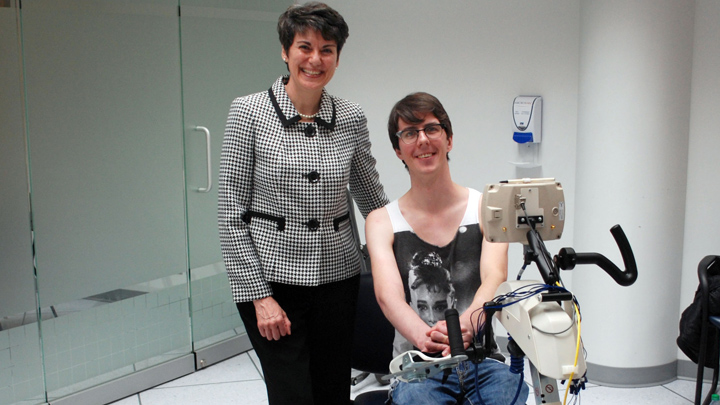
March 23, 2017

Researcher and bioengineer Dr. Vivian Mushahwar, left, has joined the Glenrose Rehabilitation Hospital as a Special Advisor to improve therapies that make a difference in the lives of patients like 26-year-old Evan Mudryk, now recovering from a stroke.
Story and photo by Shelly Willsey
EDMONTON — Evan Mudryk connects to electrodes twice a week.
It’s all part of the high-tech Functional Electrical Stimulation (FES) therapy the 26-year-old university student is using to recover from a stroke at Glenrose Rehabilitation Hospital.
The electrodes on the FES hand-cycling machine stimulate muscles in Mudryk’s arm, causing them to contract and move, which contributes to his muscle re-education and strength.
More patients like Mudryk will soon benefit thanks to a new collaboration with the Glenrose and Dr. Vivian Mushahwar, a world-class researcher and bioengineer, who has now joined the hospital as a Special Advisor in FES Technologies.
Following a spinal cord or neurological injury, some of the electrical signals don’t get through as well as they should. FES enables muscles that have been paralyzed or partially paralyzed to move again.
Dr. Mushahwar has been researching FES for the past two decades. In her advisory role, she will work closely with the Glenrose to examine current FES devices, to determine if they can be used more efficiently, and to see if the patient user group can be expanded.
“Given Dr. Mushahwar’s significant international profile, expertise and accomplishments in developing best healthcare clinical teaching practices and educational curriculums using vanguard technologies, this is an ideal match for the Glenrose,” says Isabel Henderson, Senior Operating Officer at the hospital.
“This advisory role brings the opportunity to build capacity in the area of FES technologies in rehabilitation across different programs.”
Dr. Mushahwar previously collaborated with the Glenrose to test FES technologies developed through her research, such as Smart-e-Pants — electronically wired undergarments which reduce the risk of pressure ulcers developing for patients with reduced mobility.
“The Glenrose does a fabulous job with rehabilitation,” says Dr. Mushahwar. “We are working together to find ways to apply FES in a meaningful, measurable fashion that will make a difference in patients’ lives.”
Research has shown FES improves endurance, circulation, spasticity and muscle tone in patients who still have some motor and/or sensory function.
“Working with GRH, we can look into ways where FES can make rehabilitation even better,” says Dr. Mushahwar, who’s also a professor in the Division of Physical Medicine and Rehabilitation and director of the Sensory Motor Adaptive Rehabilitation Technology (SMART) Network at the University of Alberta.
Mudryk has worked with FES devices for four years of his rehabilitation.
“I’m improving bit by bit,” says Mudryk. “I was very surprised the first time I could do a full rotation on the machine. My arm is stronger, and I’m getting better.”